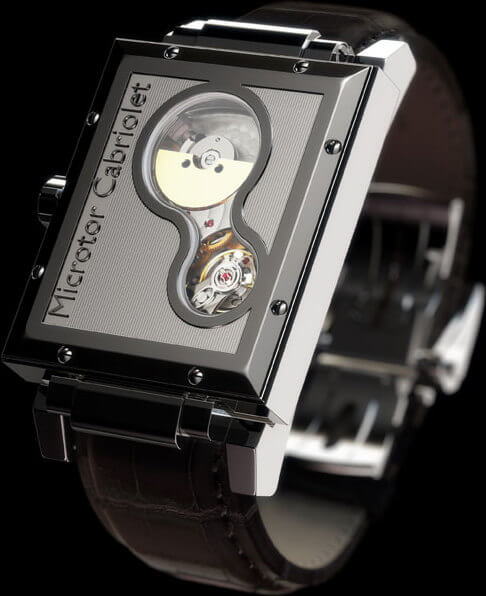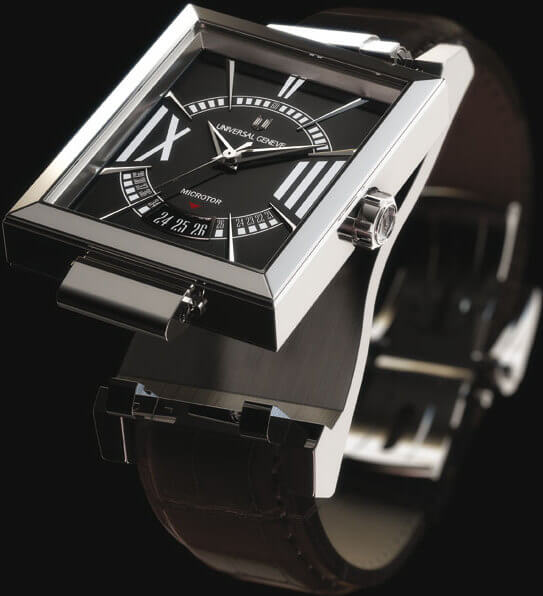“We came within a hair’s breadth of having to postpone the Microtor launch again.” Speaking in Geneva, Vincent Lapaire, the young CEO of the Universal brand, now owned by an Asian group, is visibly proud to present the new proprietary calibre, the Microtor UG 101. As the backlog of movement and parts deliveries grows, manufacturing an in-house calibre can be a testing time. “And yet it’s an essential step,” Vincent Lapaire observes, “particularly for a company rooted in tradition, such as Universal.”
Once a rite of passage for a watchmaking firm, creating an exclusive movement is now more a question of survival. As from 2010, the main source of parts for the Swiss watch industry, the Swatch Group, will be cutting off supplies. Says Vincent Lapaire, “best be prepared when the day comes. We can’t go on outsourcing indefinitely.”
Highly sought-after among collectors, up until the 1970s Universal produced innovative models, many of which left their mark on the watch industry.
A rich past
Almost 18 months behind schedule, the Microtor movement will be launched this October inside the Cabriolet reversible watch, inspired by one of Universal’s landmark models designed in 1928. Its role is to give customers what they are looking for and to pick up the thread of Universal’s illustrious past. Established in 1894 in Le Locle, the brand was favoured by Jean Cocteau, and yet despite its rich past, Universal fell victim to the onslaught of quartz. Highly sought-after among collectors, up until the 1970s Universal produced innovative models, many of which left their mark on the watch industry. In 1934, its design engineers revolutionised the chronograph with the introduction of a second pushbutton and a chronograph hour counter. Twenty years later, the firm imagined an automatic winding system with a 360° oscillating weight that significantly improved precision. This patented system would lead to the creation, in 1966, of the world’s thinnest self-winding movement (2.5mm) that went on to equip the brand’s Golden Shadow collection.
It’s hard to imagine today how a brand with so much expertise could fall so brutally into oblivion, and yet Universal struggled throughout the 1980s to overcome the backlash of quartz. It took an injection of foreign capital in the early 2000s to put the firm back on the road to success.
“Universal is back on track,” confirms Vincent Lapaire, who was appointed CEO in 2004. The brand began by thinning out then redefining its network, before gradually expanding across Asia, Europe and the Middle East, all key markets for watch sales. New collections unveiled in 2005 put Universal back in the public eye. These were all positive signals for the company’s new owners, who are now willing to invest more in the firm.
Asymmetry
“The Microtor calibre is part of the second stage in the company’s relaunch,” Vincent Lapaire explains. “Developing an exclusive movement is a long and extremely costly process. But it’s well worth it.”
And the results are there to be seen. The fruit of several years’ research and trials, the Microtor UG 101 revives the pioneering spirit that defined Universal in the 1950s. The self-winding system is driven by an off-centre micro-rotor with a superior quality chronometer escapement. It took considerable skill to develop the movement, which is housed inside a complex case structure. The Microtor Cabriolet, a nod at the original Cabriolet watch, features a pivoting system that enables the case to turn over in its cradle so that only the back is seen. “Universal invented this system in the 1920s to protect the crystal, which was made from glass, at a time when its watches were worn by a leisured class leading an active life,” the brand’s CEO explains.

The case, with its deliberate asymmetry (ed. irregular proportions), is mounted on a rotating arbor fitted with two ball pawls that position it correctly after it has pivoted 180° degrees. This ingenious mechanism protects against scratching and shocks while the micro-rotor and escapement can be admired through an aperture whose form symbolises infinity.
This technically consummate model carries with it Universal’s hopes to see the brand step back into the spotlight within the next few years. “We have already taken a substantial number of orders. However, we intend advancing one step at a time, not jumping the gun. We aim to control our growth, but much remains to be done,” admits Vincent Lapaire. The next step will be to become a veritable Manufacture that will once again master every aspect in the creation of Universal watches.













